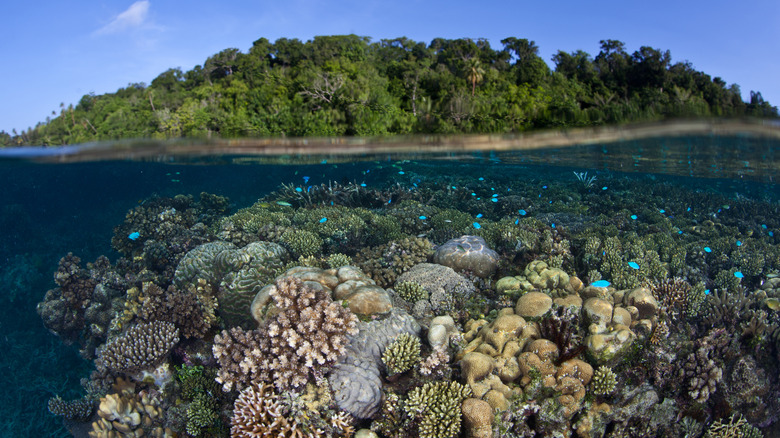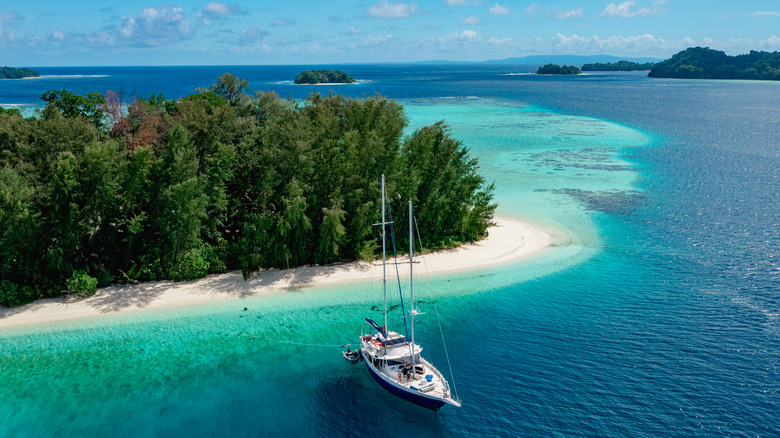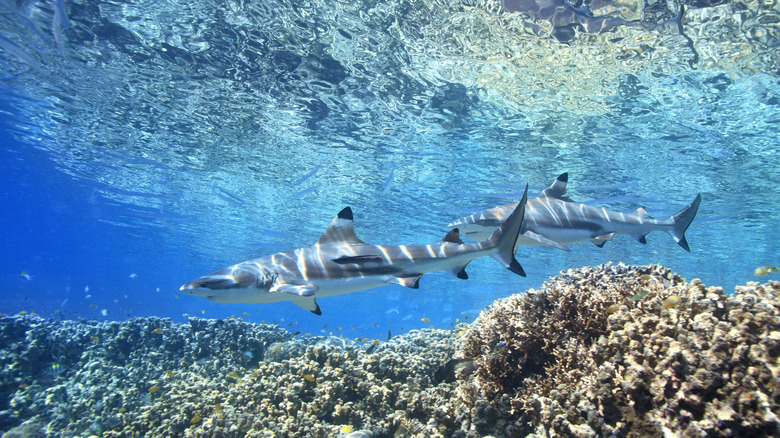The World's Largest Saltwater Lagoon Is In A Pristine Tropical Paradise Full Of Puppy-Like Docile Sharks
From the surface, Marovo Lagoon, the world's largest saltwater lagoon, may look like any other tropical paradise vacation spot, with clear, blue waters surrounded by thick forests bathed in sunshine. But underneath the surface lies a surprise: a large and healthy population of reef sharks who call the lagoon home. The local residents of this area, known as Marovians, learn to swim as soon as they can walk and spend much of their time in the water. As a result, the sharks are not afraid of people, and it's possible to get close to the creatures. As explained by Don Silcock, a diving expert in the Indo-Pacific region, these sharks, "rather than being feared, are regarded almost like dogs in that their behavior is generally docile and non-threatening."
Marovo Lagoon can be found in the New Georgia Islands, a volcanic cluster belonging to the Solomon Islands (the Solomons) in Oceania, just northeast of Australia. These secluded islands and their pristine beaches are the South Pacific's best-kept secret. Although the nation is comprised of 992 atolls and islands, only 147 are inhabited, meaning that much of its rich, natural beauty has been left untouched.
This beauty extends below the surface of the water, too. The Solomons are part of the Coral Triangle, an area of incredible marine biodiversity that spans the Indian and Pacific Oceans. This triangle is home to over 2,000 species of reef fish, along with 30% of the world's coral (600 unique species), so it's no wonder that some of the most stunning destinations for snorkeling can be found here. If you're an underwater enthusiast planning a snorkeling or scuba diving trip in the Solomons, you won't leave disappointed; along with the friendly, puppy-like Marovo Lagoon sharks, you'll see green sea turtles, moray eels, octopi, and a dazzling array of coral.
How to visit the Solomon Islands and see the sharks of Marovo Lagoon
To see the sharks up close, find accommodations near the lagoon and book a diving excursion from there. One recommended stay is at the highly rated Uepi Island Resort, a remote, private island hotel featuring six elegant beach houses. You'll be a 10-minute boat ride away from over 20 exceptional dive sites, including Uepi Point, a stunning coral-filled section of the northern barrier reef. Here, you'll view schools of grey reef sharks patrolling the area and searching for food. But to see Marovo Lagoon's enormous resident shark population, head to the Welcome Jetty. According to Jill and Grant Kelly, the resort's owners, the sharks are very comfortable being around divers. Just descend about 15 feet, stay close to the jetty, and you'll likely be approached by these curious creatures.
To reach the Solomons, fly into Honiara International Airport, located on the eastern island of Guadalcanal. From there, you can arrange domestic flights and boat transfers to your accommodations. There are also less frequent flights to Munda Airport from New Georgia, the largest in the eponymous island chain, but most connect in Honiara. You can't find direct flights from the U.S. to the Solomons, but there are one-stop flights available from Los Angeles and San Francisco.
If you're not used to a tropical monsoon climate, the weather here may be challenging. The average humidity is 85%, and the islands receive plenty of rain throughout the year. Temperatures are consistently between 75 and 88 degrees Fahrenheit, with December being the hottest month and February being the wettest. When planning your trip, note that the dry season (which still sees some rainfall) runs from May to October and will be the best time to visit.
The plight of Solomon Islands' sharks
Unfortunately, 100 million sharks are killed every year despite their importance in maintaining balance in marine ecosystems. Most are targeted on purpose (for products such as shark-fin soup), but many are killed unintentionally, as bycatch in large-scale fishing operations that incorporate gillnets or bottom trawling. There are other human actions that may not directly kill sharks but certainly impact their well-being — for example, climate change and tourism. The loss of these integral marine creatures doesn't garner a huge outcry, sadly, due to the common misconception that sharks are highly dangerous. Indeed, human injuries from these animals typically make the news, and many beachgoers express worry about a rise in shark attacks — although, in 2024, there were only seven confirmed fatalities recorded globally.
Solomon Islanders (and the people of Marovo Lagoon in particular) have a different perception of these special fish, viewing them as ancestral spirits and maintaining a respectful reverence for them — sharks are not to be killed, eaten, insulted, or even named. But despite various conservation initiatives, this shark population may still feel the negative impacts of human activity. Coastal development is increasing, and the country began receiving cruises in 2023. It's now a destination on some of the top island itineraries for new cruise ships, which has been good for the economy but also brings waste, debris, chemicals, and other forms of pollution into the water.
So if you plan to visit the islands, help these revered creatures by making good travel choices. Avoid megaship cruises, cut down on single-use plastics, and don't eat or buy products containing shark meat. Book dives with ethical eco-tour companies, and don't chase or otherwise aggravate marine life. By taking these and other actions, you'll hopefully see sharks thriving in the Solomons for the long term.


